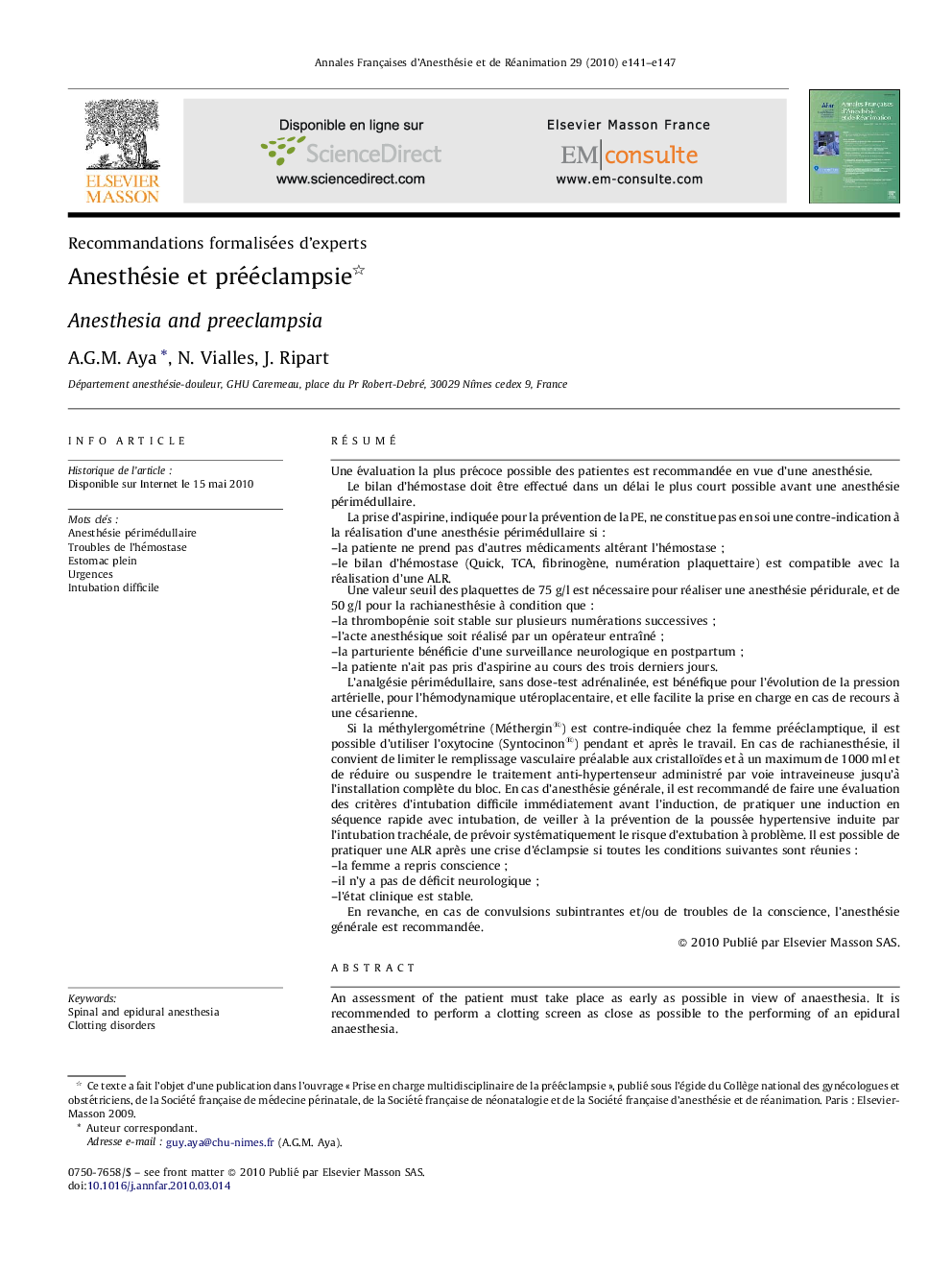| کد مقاله | کد نشریه | سال انتشار | مقاله انگلیسی | نسخه تمام متن |
|---|---|---|---|---|
| 2746274 | 1148868 | 2010 | 7 صفحه PDF | دانلود رایگان |

RésuméUne évaluation la plus précoce possible des patientes est recommandée en vue d’une anesthésie.Le bilan d’hémostase doit être effectué dans un délai le plus court possible avant une anesthésie périmédullaire.La prise d’aspirine, indiquée pour la prévention de la PE, ne constitue pas en soi une contre-indication à la réalisation d’une anesthésie périmédullaire si :–la patiente ne prend pas d’autres médicaments altérant l’hémostase ;–le bilan d’hémostase (Quick, TCA, fibrinogène, numération plaquettaire) est compatible avec la réalisation d’une ALR.Une valeur seuil des plaquettes de 75 g/l est nécessaire pour réaliser une anesthésie péridurale, et de 50 g/l pour la rachianesthésie à condition que :–la thrombopénie soit stable sur plusieurs numérations successives ;–l’acte anesthésique soit réalisé par un opérateur entraîné ;–la parturiente bénéficie d’une surveillance neurologique en postpartum ;–la patiente n’ait pas pris d’aspirine au cours des trois derniers jours.L’analgésie périmédullaire, sans dose-test adrénalinée, est bénéfique pour l’évolution de la pression artérielle, pour l’hémodynamique utéroplacentaire, et elle facilite la prise en charge en cas de recours à une césarienne.Si la méthylergométrine (Méthergin®) est contre-indiquée chez la femme prééclamptique, il est possible d’utiliser l’oxytocine (Syntocinon®) pendant et après le travail. En cas de rachianesthésie, il convient de limiter le remplissage vasculaire préalable aux cristalloïdes et à un maximum de 1000 ml et de réduire ou suspendre le traitement anti-hypertenseur administré par voie intraveineuse jusqu’à l’installation complète du bloc. En cas d’anesthésie générale, il est recommandé de faire une évaluation des critères d’intubation difficile immédiatement avant l’induction, de pratiquer une induction en séquence rapide avec intubation, de veiller à la prévention de la poussée hypertensive induite par l’intubation trachéale, de prévoir systématiquement le risque d’extubation à problème. Il est possible de pratiquer une ALR après une crise d’éclampsie si toutes les conditions suivantes sont réunies :–la femme a repris conscience ;–il n’y a pas de déficit neurologique ;–l’état clinique est stable.En revanche, en cas de convulsions subintrantes et/ou de troubles de la conscience, l’anesthésie générale est recommandée.
An assessment of the patient must take place as early as possible in view of anaesthesia. It is recommended to perform a clotting screen as close as possible to the performing of an epidural anaesthesia.The use of aspirin, if indicated for the prevention of PE, does not as such, constitute a contraindication to performing an epidural anaesthesia if:–No other medication altering the homeostasis is being used concomitantly.–If her clotting screen (INR, ATTP, Fibrinogen levels, platelet count) is compatible with such a technique.With regards to the minimum platelet count, the recommended cut-off value for the performing of an epidural and spinal anaesthesia are 75 & 50·109/l respectively, only if all of the following conditions are met:–The thrombocytopenia is stable on several consecutive counts.–The procedure will be carried out by an experienced operator.–Post partum neurological monitoring will be performed.–The patient did not, over the past 3 days, take aspirin.It is recommended to quickly set up an epidural anaesthesia because this will improve the blood pressure as well as the utero-placenteric haemodynamics and also because this will facilitate the management in case of a caesarean section.Whereas methylergometrine (Methergin®) is contraindicated in the preeclamptic patient, it is possible to use oxytocin (Syntocinion®) during and after labour.Before performing a spinal anaesthesia, it is recommended to restrain the administration of crystalloids to a maximum of 1000 ml.Also the i.v. antihypertensive treatment should be reduced or interrupted until complete establishment of the anaesthetic.In case a general anaesthesia is to be performed, an assessment of the criteria for difficult intubation should be performed immediately prior to the induction.The technique employed should be a rapid sequence induction with intubation, while preventing a surge in blood pressure induced by the tracheal intubation. Difficulties to extubate should systematically be anticipated.It is possible to perform a loco-regional anaesthesia following an eclamptic crisis if the following conditions are met:–The woman has regained consciousness.–She doesn’t have any neurological deficit.–She is clinically stable.In case of overlapping seizures and/or impaired consciousness, a general anaesthesia is recommended.
Journal: Annales Françaises d'Anesthésie et de Réanimation - Volume 29, Issue 5, May 2010, Pages e141–e147